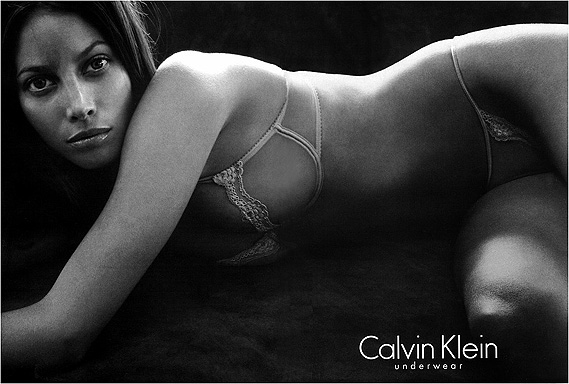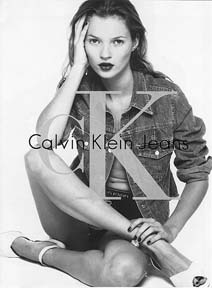 |
 |
 |
| Figure 5g |
Figure 7a |
Figure 7b |
 |
 |
| Figure 8a |
Figure 8b |
The focus of advertisement will remain in "[aiming productivity
towards producing] meanings that are relevant to everyday life" (Fiske 1989, 6). Therefore,
there will always be a message within a visual image but the message may prove to be difficult
to interpret. This is where semiotics help in understanding a bit more about a piece of
advertisement. Judith Williamson describes how "we can only understand what advertisements
mean by finding out how they mean, and analyzing the way in which they work" (Williamson 17).
Within every piece of advertisement there exists a signifier and a signified, which make up a
sign. A signifier is "the material object" and the signified is "its meaning" (Williamson 17).
Using Figure 5g, an example of a signifier would be the giant text of "cK", the signified would
be that the text stands for Calvin Klein. So just by taking the first sign that is found in
the center of the ad the viewer can say that the ad claims to be about a brand, or more
specifically a clothing brand. Then from here one would continue to use every sign within
the ad. For example, the woman herself is a signifier and her signified would be female,
femininity, or even comfort. As Subject B put it "she looks like she's selling something
comfortable [...] she seems relaxed" (Interview 8). Because of the fact that the woman is also
a famous model she caries an even bigger signified, which is an icon. An icon is "[a signifier
that] represents the signified by apparently having a likeness to it" (Rose 83). Now, because
Kate Moss, the model in the ad, carries a name of bohemian-chic style the signified is now in
relation to comfort, stylish, and bohemian-chic because the signifier now carries an extra
meaning. Other examples of how brands use famous figures to heighten their ad appeal can be
seen in Figures 7b, 8a, and 8b. Figure 7b shows Eva Mendes advertising women's cK lingerie.
Subject B discussed how because cK chose to use Eva Mendes that the ad produces a stronger
sexual image then that of Figure 7a, which is advertising the same lingerie (Interview 10).
Sometimes icons can prove to be much more powerful then the consumer leads on for them to be.
Subject B stated how because "[Eva Mendes] is an actress known for taking her clothes off in
movies she gives off that sexy image" (Interview 11). This sexy image that Eva carries is what
is then carried onto the cK brand and gives the consumer an idea that the product will have
them feeling and looking as sexy and seductive as Eva does. While sometimes the image can give
the signs that it's sexy and seductive, other times the image can give off a powerful and
strong idea. Subjects A and B both discussed how Figures 8a and 8b gave off a "badass" idea
with their underwear ads (Interview 12). Mark Wahlberg gives off a strong and powerful idea
by himself, and then with Mario Lopez the same concept is conceptualized with the same pose as
Mark Wahlberg. By using these two strong, muscular, sexually appealing men cK called out to
the female consumer to get them to see and notice the ad. At the same time male consumers could
want to feel that power and confidence that Wahlberg and Lopez give off. However, Subject C
discussed how he would see the ad as just an ad and could not see the idea of comfort or
confidence in it (Interview 12). This is another example of how an image can take on a
different appeal or meaning for a different person. For reasons like this, brands probably saw
a stronger influence on consumers when they would use famous faces with their products because
then a higher level of meaning was given to the product.
 |
 |
 |
 |
| Figure 5a |
Figure 5b |
Figure 5c |
Figure 6b |
When the interview group was given the figures that were from earlier
publications of cK and those that were published more recently they identified a significant
different in them - sex and nudity. They discussed how the new ones have "a lot more nudity [...]
less clothes [...] more sex and touching [...]" (Interview 2, 4, 7). When they analyzed the older ads,
Figures 5a-g, they noted how the "cK" or "Calvin Klein" logo is more visible than in the newer ads
where the brand is either in small print or completely missing (Interview 8). They also noted how
the location of the brand name has also changed the context of the ad. In the newer publications
the logo is found very close to a woman's crotch, Figure 6b. However, in the older publications
the logo is found on the bottom, top, or dead center of the ad. This is again a way that cK chooses
to emphasize a level of sexual imagery in the need to position the logo between or on a woman's
crotch. One analysis that all the Subjects agreed on was that the early publications focused
on ""the actual clothing" (Interview 9). The poses the models are found in, the fact that they are
wearing more clothing, and the simple facial expressions that each has describes how the aim was
more on an actual model pose than on making the model wear less and give off a "sex sells" appeal.
Just by taking simple views of an image, different poses, and the icons in them the meaning of
an advertisement changes or even strengthens. Subjects A, B, and C agreed that based on what they
saw in the ads they could see how cK used nudity and sex to give consumers the idea that they can
have what they were seeing.
Print Me Calvin Klein |
cK Says "Show Me Quality" |
Just Think cK |
Flash...Snap...Sex! |
What's Your Culture Kingdom? |
Who Owns You? |











